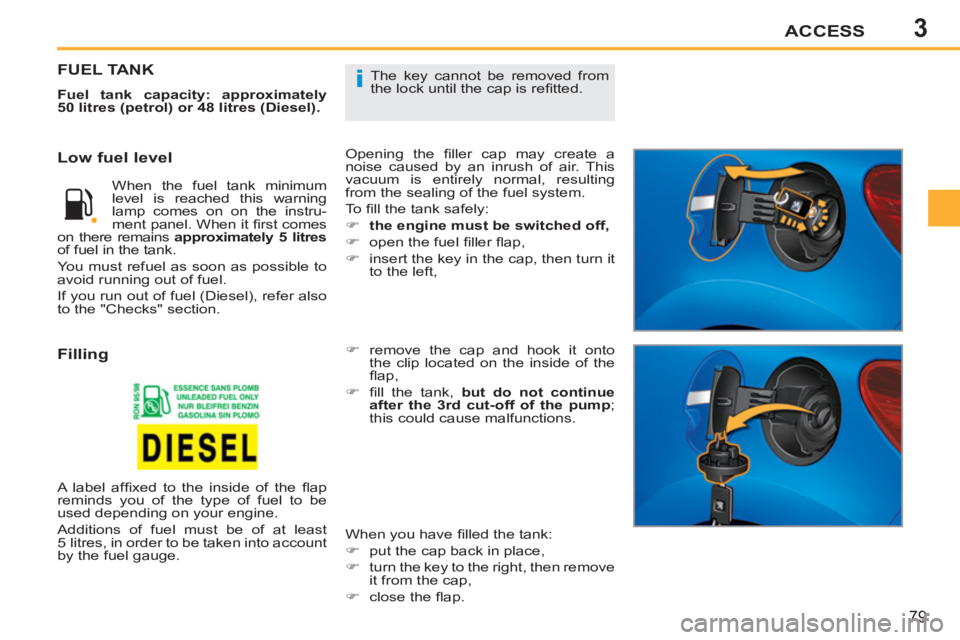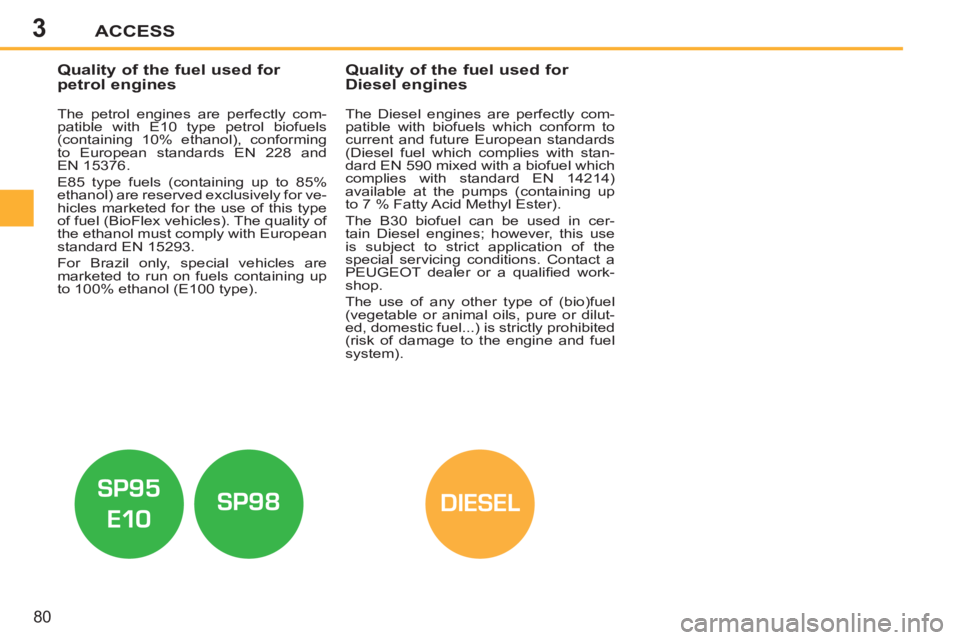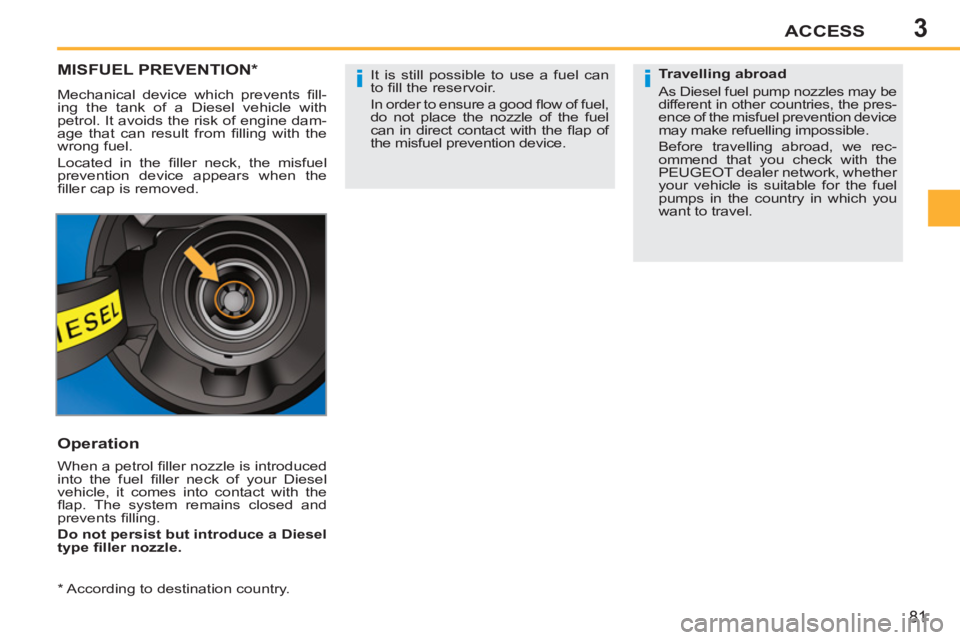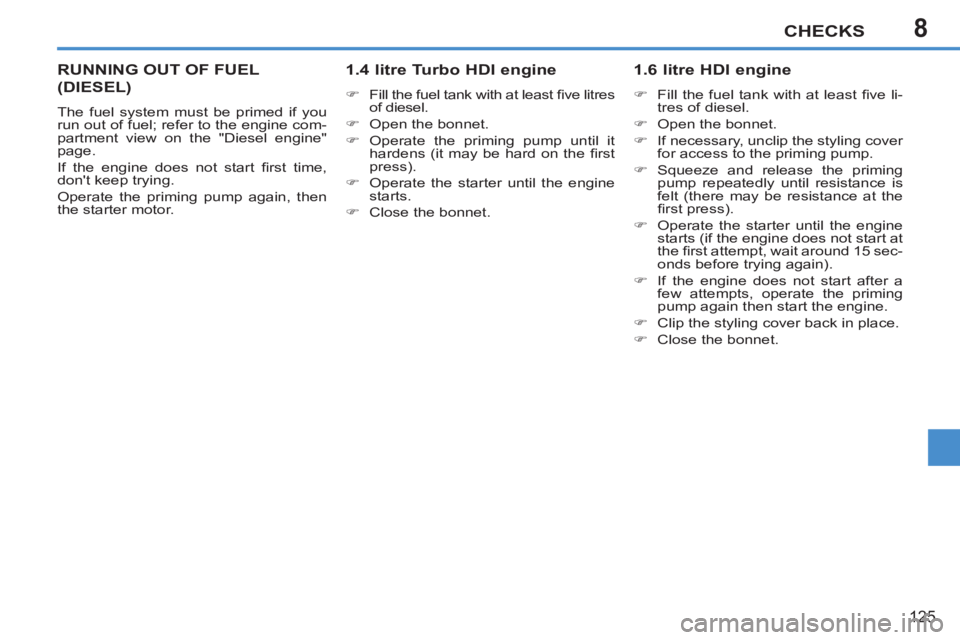Page 81 of 248

3
i
ACCESS
79
The key cannot be removed from
the lock until the cap is refi tted. FUEL TANK
Fuel tank capacity: approximately
50 litres (petrol) or 48 litres (Diesel).
Opening the fi ller cap may create a
noise caused by an inrush of air. This
vacuum is entirely normal, resulting
from the sealing of the fuel system.
To fi ll the tank safely:
�)
the engine must be switched off,
�)
open the fuel fi ller fl ap,
�)
insert the key in the cap, then turn it
to the left,
When you have fi lled the tank:
�)
put the cap back in place,
�)
turn the key to the right, then remove
it from the cap,
�)
close the fl ap.
�)
remove the cap and hook it onto
the clip located on the inside of the
fl ap,
�)
fi ll the tank, but do not continue
after the 3rd cut-off of the pump
;
this could cause malfunctions.
Low fuel level
Filling
When the fuel tank minimum
level is reached this warning
lamp comes on on the instru-
ment panel. When it fi rst comes
on there remains approximately 5 litres
of fuel in the tank.
You must refuel as soon as possible to
avoid running out of fuel.
If you run out of fuel (Diesel), refer also
to the "Checks" section.
A label affi xed to the inside of the fl ap
reminds you of the type of fuel to be
used depending on your engine.
Additions of fuel must be of at least
5 litres, in order to be taken into account
by the fuel gauge.
Page 82 of 248

3
DIESEL
ACCESS
80
Quality of the fuel used for
petrol engines
Quality of the fuel used for
Diesel engines
The petrol engines are perfectly com-
patible with E10 type petrol biofuels
(containing 10% ethanol), conforming
to European standards EN 228 and
EN 15376.
E85 type fuels (containing up to 85%
ethanol) are reserved exclusively for ve-
hicles marketed for the use of this type
of fuel (BioFlex vehicles). The quality of
the ethanol must comply with European
standard EN 15293.
For Brazil only, special vehicles are
marketed to run on fuels containing up
to 100% ethanol (E100 type).
The Diesel engines are perfectly com-
patible with biofuels which conform to
current and future European standards
(Diesel fuel which complies with stan-
dard EN 590 mixed with a biofuel which
complies with standard EN 14214)
available at the pumps (containing up
to 7 % Fatty Acid Methyl Ester).
The B30 biofuel can be used in cer-
tain Diesel engines; however, this use
is subject to strict application of the
special servicing conditions. Contact a
PEUGEOT dealer or a qualifi ed work-
shop.
The use of any other type of (bio)fuel
(vegetable or animal oils, pure or dilut-
ed, domestic fuel...) is strictly prohibited
(risk of damage to the engine and fuel
system).
Page 83 of 248

3
ii
ACCESS
81
MISFUEL PREVENTION *
Mechanical device which prevents fi ll-
ing the tank of a Diesel vehicle with
petrol. It avoids the risk of engine dam-
age that can result from fi lling with the
wrong fuel.
Located in the fi ller neck, the misfuel
prevention device appears when the
fi ller cap is removed.
Operation
When a petrol fi ller nozzle is introduced
into the fuel fi ller neck of your Diesel
vehicle, it comes into contact with the
fl ap. The system remains closed and
prevents fi lling.
Do not persist but introduce a Diesel
type fi ller nozzle.
It is still possible to use a fuel can
to fi ll the reservoir.
In order to ensure a good fl ow of fuel,
do not place the nozzle of the fuel
can in direct contact with the fl ap of
the misfuel prevention device.
Travelling abroad
As Diesel fuel pump nozzles may be
different in other countries, the pres-
ence of the misfuel prevention device
may make refuelling impossible.
Before travelling abroad, we rec-
ommend that you check with the
PEUGEOT dealer network, whether
your vehicle is suitable for the fuel
pumps in the country in which you
want to travel.
*
According to destination country.
Page 127 of 248

8CHECKS
125
RUNNING OUT OF FUEL
(DIESEL)
The fuel system must be primed if you
run out of fuel; refer to the engine com-
partment view on the "Diesel engine"
page.
If the engine does not start fi rst time,
don't keep trying.
Operate the priming pump again, then
the starter motor.
1.4 litre Turbo HDI engine
�)
Fill the fuel tank with at least fi ve litres
of diesel.
�)
Open the bonnet.
�)
Operate the priming pump until it
hardens (it may be hard on the fi rst
press).
�)
Operate the starter until the engine
starts.
�)
Close the bonnet.
1.6 litre HDI engine
�)
Fill the fuel tank with at least fi ve li-
tres of diesel.
�)
Open the bonnet.
�)
If necessary, unclip the styling cover
for access to the priming pump.
�)
Squeeze and release the priming
pump repeatedly until resistance is
felt (there may be resistance at the
fi rst press).
�)
Operate the starter until the engine
starts (if the engine does not start at
the fi rst attempt, wait around 15 sec-
onds before trying again).
�)
If the engine does not start after a
few attempts, operate the priming
pump again then start the engine.
�)
Clip the styling cover back in place.
�)
Close the bonnet.
Page 129 of 248
8CHECKS
127
DIESEL ENGINES
The caps and covers provide access for checking the levels of the various fl uids, to replace certain components and to prime
the fuel system.
1.
Coolant reservoir.
2.
Passenger compartment fi lter.
3.
Screenwash and headlamp wash
reservoir.
4.
Priming pump.
5.
Brake fl uid reservoir.
6.
Fusebox.
7.
Battery.
8.
Engine oil dipstick.
9.
Engine oil fi ller cap.
10.
Air fi lter.
Page 153 of 248

9PRACTICAL INFORMATION
151
Engine compartment fuses
The fusebox is placed in the engine
compartment, near the battery (left-
hand side).
Access to the fuses
�)
Unclip the cover.
�)
Replace the fuse (refer to the cor-
responding paragraph).
�)
When you have fi nished, carefully
close the cover carefully to ensure
correct sealing of the fusebox.
Fuse table
Fuse N°
Rating
Functions
F1
20 A
Engine control unit and fan assembly control relay
supply, timing and canister electrovalves (1.6 litre
16V THP), air fl ow sensor (Diesel), injection pump
(Diesel), water in diesel sensor (Diesel), EGR
electrovalves, air heating (Diesel).
F2
15 A
Horn.
F3
10 A
Front and rear screenwash.
F4
20 A
Headlamp wash.
F5
15 A
Fuel pump (petrol), Turbo electrovalves (1.6 l 16V
THP).
F6
10 A
Vehicle speed sensor, automatic gearbox.
F7
10 A
Electric power steering, switching and protection
unit (Diesel).
F8
25 A
Starter motor control.
F9
10 A
ABS/ESP control unit, brake pedal switch.
F10
30 A
Engine control unit actuators (petrol: ignition coils,
electrovalves, oxygen sensors, injectors, heaters,
electronic thermostat) (Diesel: electrovalves,
heaters).
F11
40 A
Air conditioning blower.
F12
30 A
Windscreen wipers Low/High speed.